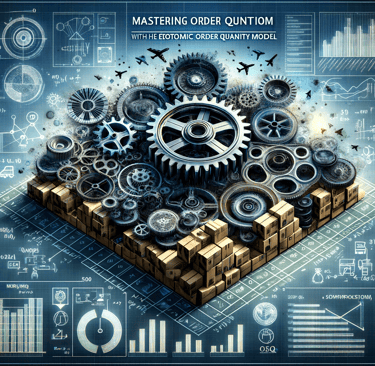Economic Order Quantity (EOQ) Model.
What is Economic Order Quantity (EOQ)? Learn the formula to minimize inventory costs, see a step-by-step calculation example, and understand when to use it.
SUPPLY CHAIN
The Procure 4 Marketing Team
2/7/20243 min read


Quick Answer: What is EOQ?
Economic Order Quantity (EOQ) is a formula used in inventory management to determine the ideal order quantity that minimizes total inventory costs. It calculates the "sweet spot" between ordering costs (shipping, admin) and holding costs (storage, insurance). By ordering this exact amount, businesses ensure they meet demand without tying up excess cash or wasting money on frequent shipments.
The Inventory Tug-of-War: Why We Need EOQ
Every inventory manager faces a fundamental conflict:
If you order small amounts frequently: You reduce your storage costs, but your ordering and shipping costs skyrocket.
If you order huge amounts infrequently: You save on shipping, but your storage costs (rent, insurance, spoilage) eat up your margins.
EOQ (Economic Order Quantity) is the mathematical solution to this problem. It finds the exact point where the combined cost of ordering and holding inventory is at its absolute lowest.
The Formula: How to Calculate EOQ
The formula might look intimidating, but it relies on just three variables you likely already track.
EOQ = sqrt(2DS/H)
The Variables:
D (Demand): The total number of units you sell in a year.
S (Setup/Ordering Cost): The flat cost to place a single order (includes shipping, handling, and admin time).
H (Holding Cost): The cost to hold one unit in inventory for a year (usually calculated as a percentage of the item's value).
A Real-World Example: The Laptop Retailer
Let's say you run a store selling high-end laptops. You want to know how many to order at a time to save the most money.
Annual Demand (D): You sell 1,000 laptops a year.
Ordering Cost (S): It costs you $50 in shipping and admin every time you place an order with the manufacturer.
Holding Cost (H): It costs you $20 to store one laptop safely for a year.
The Calculation:
2 x D x S = 2 x 1,000 x 50 = 100,000
Divide by H = 100,000 / 20 = 5,000
Square Root = sqrt{5,000} = 70.7
The Result: Your EOQ is 71 laptops.
Instead of ordering 10 laptops every week (high shipping costs) or 500 laptops twice a year (high storage costs), you should place an order for 71 laptops roughly 14 times a year. This is the most cost-effective strategy.
When Should You Use EOQ (and When Should You Not)?
EOQ is a powerful tool, but it relies on assumptions. It works best for stable businesses.
✅ Use EOQ When:
Customer demand is consistent and predictable throughout the year.
Ordering and holding costs are known and stable.
You want to automate reorder quantities for "evergreen" products.
❌ Be Careful With EOQ When:
Seasonality: If you sell snow shovels, using an annual average for demand will leave you overstocked in July and sold out in January.
Bulk Discounts: The formula doesn't account for supplier discounts. If ordering 100 units gets you a 20% discount, that might be cheaper than your calculated EOQ of 71 units.
Fluctuating Costs: If shipping rates are volatile, the S variable changes, throwing off the calculation.
Frequently Asked Questions (FAQ)
Q1: What is the difference between EOQ and MOQ?
A: EOQ (Economic Order Quantity) is the ideal amount you calculate to save money. MOQ (Minimum Order Quantity) is the smallest amount a supplier will allow you to buy. If your EOQ is 50 but the supplier's MOQ is 100, you generally have to order 100 (unless you can negotiate).
Q2: Does EOQ tell me when to reorder?
A: No. EOQ tells you how much to buy. To know when to buy, you need to calculate your Reorder Point (ROP) based on your lead time and safety stock. EOQ and ROP work together.
Q3: Can I use EOQ for all my products?
A: You should prioritize it. Calculating EOQ takes time (or software). Apply it to your "Class A" inventory—the high-value, high-volume items where efficiency makes the biggest financial difference (Pareto Principle).

